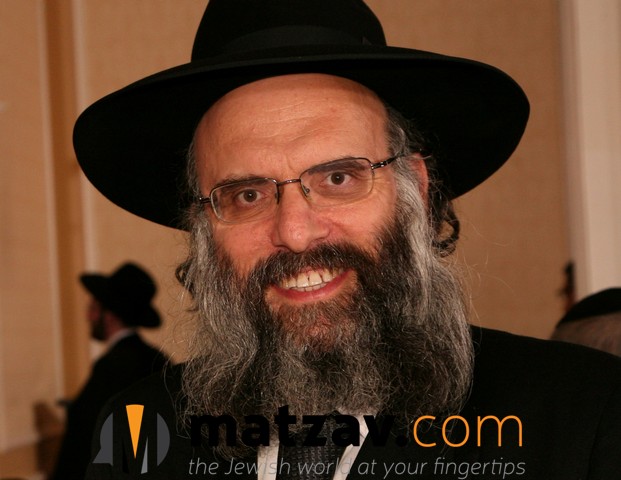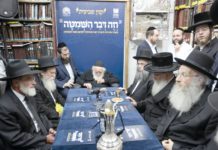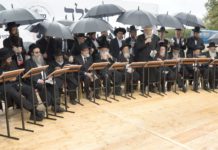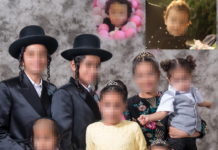
By Rabbi Yehoshaui Feldman
Vayakhel
Contents:
1 – Morah Shabbos
2 – Nesius Lev
3 – Pirush of the word al
4 – Dayam v’hoser
5 – Vayechaber vs. l’chaber
6 – Quote of the Week
7 – Featured Story
1 – Morah Shabbos ביום השביעי יהיה לכם קדש שבת שבתון לה’ לה:ב
The Sefer Yereim has a unique opinion that one of the taryag mitzvos is morah Shabbos. He obviously had that as his girsah in the Gemara when it makes a hekesh between Shabbos and the Mikdash, based on the pasuk in parshas Kedoshim (19:30). Just like there is a halacha of morah Mikdash, behaving in a manner of respectful awe when you’re in the Mikdash, so too does that apply to Shabbos.
Now, as far as the Mikdash is concerned, how this respectful awe must express itself is explicit halachos. Most of them are delineated in the end of Maseches Brachos. For example, not wearing shoes or carrying a purse. And so on. However, as far as Shabbos is concerned the Gemara leaves it undefined.
The Yereim says that the expression of this morah is to be involved and concerned with kavod Shabbos. To act in general in a manner befitting of Shabbos. Of course, that is in addition to the most basic concern of observing all of the halachos of Shabbos properly.
The understanding of this is based on an idea that we mentioned previously. Namely, that just as there is kedusha in the dimension of space, so too is their kedusha in the dimension of time. The Mikdash is the particular space which is reshus Gavoha, the reshus ha’yachid of Yechido shel Olam – the domain of Ha’Kadosh Baruch Hu. Even though la’Hashem ha’aretz u’meloah, still, v’ha’aretz nasan l’vnei adam. That means that in general we have permission and have been granted a license to make ourselves at home, as the saying goes, here in this world. Hashem gives it to us to be ours, even though really it’s His.
But when you go into reshus Gavoha, into the domain that Ha’Kadosh Baruch Hu sets aside exclusively as His, then one does not have a license to behave in a “make yourself at home” type of way. He is in the domain, kavayachol, of Ha’Kadosh Baruch Hu, and he therefore must conduct himself accordingly with the appropriate sense of respectful awe.
Shabbos is the reshus Gavoha in the dimension of time. It is a time frame that belongs exclusively to the domain of Ha’Kadosh Baruch Hu. It therefore requires the same demeanor of respectful awe.
The truth is, though, that this really is an opportunity to be “normal”. To be who we really are. Throughout the week we are pushed and pulled in so many different directions by all types of considerations that, in a very real sense, are estranged from our true essence. But on Shabbos, which is kulo kodesh la’Hashem, you get a chance to be normal; like a mensch! So it is not a burden, but a pleasure.
(Audio recording available here)
————————–
2 – Nesius Lev
The Ramban brings our attention to the fact that the expression of nesius lev (nesao libo, lit. his heart lifted him) only appears regarding those that engaged in the fashioning of the various parts of the Mishkan, whereas by those who donated to the cause the expression employed is nedivus lev (generosity). The reason for this discrepancy, explains the Ramban, is that the Jewish People had become accustomed to coarse labor – of mortar and bricks – and had none amongst them who could teach the fine arts of jewel-setting, wood crafting, weaving, and so on. Hashem simply implanted the natural talents needed for these fine skills into their hearts and vayigbah libo b’darchei Hashem – they boldly came before Moshe to volunteer to do the work of fine craftsmanship that Hashem had commanded.
What we see from this Ramban is that, in order for the Jews in the Midbar to be able to build the Mishkan, they needed two things: 1) special siyata d’Shmaya that Hashem implanted the natural talents into their hearts, and 2) a tremendous drive and desire to carry out the work of Hashem. To whom did Ha’Kadosh Baruch Hu give the wisdom of fine craftsmanship? B’lev kol chacham lev, into the hearts of the wise of heart. Those who possessed a tremendous yearning to fulfill the ratzon of Hashem to build the Mishkan were the ones who were given the special siyata d’Shmaya to inherently know how to do it.
There is a very powerful mussar haskel here. Oftentimes, we sell ourselves short by taking our yearnings and aspirations for granted. Whatever they are, we think, they are, and there’s really nothing we can do about that. But, in fact, nothing could be further from the truth. A big part of avodas Hashem is cultivating the right sheifos (yearnings and aspirations). For example, if someone hRas a negative middah that needs correcting, it’s not only the practical, behavioral conditioning that is part of working on that middah, but also yearning for the correction of that middah as well.
Rav Simcha Bunim of Pshischa said a powerful vort: Why does Dovid Ha’Melech say, achas shaalti mei’eis Hashem osah avakeish? Once he expressed that he has but one request of Hashem – namely, shivti b’veis Hashem kol yemei chayai, to dwell in the Beis Hashem his whole life – why does he need to repeat, osah avakeish, “this is what I ask for”? The pshat, explained Rav Simcha Bunim, is that it is not simply that Dovid Ha’Melech is asking Ha’Kadosh Baruch Hu to dwell in the Beis Hashem his whole life, but that dwelling in the Beis Hashem should be osah avakeish. That that which he should always yearn for and aspire to should be to dwell in the Beis Hashem. Dovid Ha’Melech is pleading with the Ribbono shel Olam, “Please help me that my yearning and aspiration in life should always be to dwell in the Beis Hashem!”
We don’t have to “settle” for our current yearnings and aspirations. We can and should daven to the Ribbono shel Olam that He should inspire our hearts to be possessed of the right yearnings and aspirations. To always want to do the right thing.
(From the notes of Rebbetzin Twersky)
——————————
3 – Pirush of the word al ויבאו האנשים על הנשים לה:כב
There are numerous approaches in the mefarshim regarding how to explain this enigmatic expression. Rashi learns that the word al in this context means im, with. That the men came along with the women to donate the jewelry.
The Sforno says a very interesting thing to explain why it was necessary for the men to escort their wives in this donation. The halacha is that a tzedaka collector is allowed to accept small size donations from women because we assume that her husband would not mind. However, large donations may not be accepted from women because it is possible she is giving it without the consent of her husband, and, were he to know, he would object (Bava Kama 119a). Since these donations of jewelry were certainly large size donations, the men came along to confirm their agreement.
The Ramban explains that it means that the women were the ikar and the men were the tafel. The women were the ones who were the primary initiators, the main menadvim – at least in the context of this donation of jewelry – and the men were ancillary to them.
The Chiddushei Ha’Rim, on the other hand, explains it in the opposite manner: al does not mean that the men were secondary to the women. On the contrary, it means that they were superior to them. Why?
Only the men had sinned in the eigel ha’zahav and not the women. This is the way the Gra explains the pasuk, “isha v’chol eileh lo matzasi” (Koheles 7:28) – that there was not even one woman who took part in the cheit ha’eigel. Therefore, continues the Chiddushei Ha’Rim, the men were on a higher level. Why? “B’makom sheh’baalei teshuva omdin afilu tzaddikim gemurim einan yecholin laamod, baalei teshuva occupy a lofty level that even complete tzaddikim cannot occupy.” They put their heart and soul into their contributions towards the Mishkan, and it was a part of their tikun for the cheit ha’eigel.
(Audio recording available here)
————————
4 – Dayam v’hoser והמלאכה היתה דים…והותר לו:ז
What does it mean that the donations of Klal Yisrael were dayam, which means sufficient, and hoser, which means that there was left over? The Sefas Emes says that the word dayam is like the word dee in the context of dee zahav (Devarim 1:1). There, Rashi brings the Chazal that dee zahav is hinting to the cheit ha’eigel. The Gemara says that Moshe Rabbeinu defended Klal Yisrael by saying to the Ribbono shel Olam, “It’s the abundance of gold and silver that you gave to them that caused them to sin!” The dayam of donating gold and silver (etc.) for the construction of the Mishkan is the atonement of the misappropriation of their gold and silver in the sin of the eigel ha’zahav. By them doing this, their gold and silver (etc.) was uplifted, which is implied in the word hoser.
This is in line with the Midrash that says (on the words tov meod by maaseh breishis), tov is referring to the yeitzer ha’tov and meod is referring to the yeitzer hara. Really, the whole purpose of the yeitzer hara is to enable a person to accomplish much greater things than he would otherwise reach. Although people “look for many calculations” (bikshu chishvonos rabim) and unfortunately put the yeitzer hara to use for the wrong things, that’s not what it is for. We can and should draft the yeitzer hara for the tzad ha’kedusha by having it push us forward to achiever much higher levels of ruchniyus.
Coming at this pasuk from a different angle, the Shlah Ha’Kadosh says that it was actually a miracle that the donations for the Mishkan sufficed. He says that if you go through all the components, piece by piece and detail by detail, and carefully tally up all the raw material that would be needed to make everything, you’ll realize that what was donated was not enough. Through a neis it sufficed.
Interestingly enough, the Ohr Ha’Chaim Ha’Kadosh says the exact opposite: really, it was hoser – the amount that Klal Yisrael donated was too much. However, through a miracle it all fit. When they put the materials to use and made everything, every last bit that was donated was used up and it came out perfectly that there was dayam, just enough. Nobody’s nedavah was left out. According to the Ohr Ha’Chaim, it was a bigger miracle.
(Audio recording available here)
——————-
5 – Vayechaber vs. l’chaber
חמשים קרסי זהב ויחבר…קרסי נחשת חמשים לחבר לו:י,יח
These pesukim are an example of the careful attention with which we should learn these parshiyos. The dichotomy leaps out. Why is it that by the golden clasps of the bottom cover of the Mishkan (that the pasuk just calls “mishkan”) the word fifty comes first, whereas by the bronze clasps of the second cover (made out of goat hair) it first says bronze clasps and then says fifty? Secondly, why is it that by the golden clasps it says vayechaber, he connected them (the tarps), whereas by the bronze clasps it says it in the infinitive form l’chaber, to connect them?
Regarding the order of the wording, the Meshech Chochma says that when it came to the gold clasps they made precisely fifty of them, whereas the bronze ones they made a certain, undefined amount and they took from that amount fifty for the second tier tarps. The Meshech Chochma says this without really explaining it so much, and the question remains to a large degree unanswered.
As far as the difference between vayechaber (by the bottom layer covering) and l’chaber (of the second layer covering), the Meshech Chochma says that Betzalel didn’t just set up all the tarps to be connected, rather he actually connected them. Vayechaber, and he connected them. However, when it came to the second layer of coverings (made from goat hair), it was l’chaber, to be connected. Meaning, Betzalel set everything up in order to get it ready to be connected. Moshe Rabbeinu, though, was the one who actually connected the tarps of the second layer covering.
Of course, it needs to be understood why it is that specifically the yerios izim (the second layer covering) should be connected by Moshe Rabbeinu. Tzarich iyun.
(Audio recording available here)
——————–
6 – Quote of the Week
“If you come across something in your learning that relates to parshas ha’shavuah, it is a good sign. It means that you are on the right track.”
———————–
7 – Featured Story
One day I was walking Rav Twersky out from mincha and I asked him a question (I always tried to have questions to ask him, but when you have a person who answers every single question of yours, you run out of them pretty fast!). I said, “How can it be that all of Beis Shammai learned the sugyah the same way, and all of Beis Hillel learned the sugyah a different way? Were there no dissenters in each yeshiva? How can a whole yeshiva always learn and conclude in a more lenient way, and a whole other yeshiva learn and conclude in a more machmir way?” Rebbi responded, “Of course, that was their shoresh ha’neshama…Do you think you just ended up in this particular yeshiva?”
(Reb Mickey Dov Lebovic)
~Click here to download TWO PAGES PDF (if printed double sided, otherwise it’s four pages)~
~Click here to download ONE PAGE PDF (if printed double sided, otherwise it’s two pages~
Pekudei
Contents:
1 – Who is Chur?
2 – Tzarich Iyun Gadol on the Rambam
3 – A Brisker Ramban
4 – Quote of the Week
5 – Featured Story
1 – Who is Chur? ובצלאל בן אורי בן חור לח:כב
The pasuk is making a point to trace Betzalel’s lineage back to his grandfather, Chur. This is not the first time we discover Chur. At the end of parshas Beshalach (17:12), Aharon and Chur held up Moshe Rabbeinu’s arms while Yehoshua led the battle against Amaleik. At the end of parshas Mishpatim, Moshe Rabbeinu tells the People that, while he is gone, anyone who has a din Torah that needs to be settled should bring it to Aharon and Chur. Also in parshas Ki Sisah, Chur comes up. Rashi brings the Medrash that what Aharon saw (32:5) is the murder of Chur when he rebuked the People for wanting to make the eigel ha’zahav.
Who was Chur? He was the son of Miryam and Kaleiv. Rashi tells us so three times! In Beshalach, in Mishpatim, and also in Vayakhel (35:30) when the pasuk mentions that Betzalel is the grandson of Chur. Throughout Shas, Rashi repeats explanations and does not rely on your memory. Once it’s two or three daf away from where he first explained it, Rashi does not hesitate to explain again. Sometimes, if it is a lengthy exposition, he’ll tell you, “I already explained this in such and such place.” That is certainly quite reasonable. Otherwise, though, he reiterates things often and does not rely on us to remember what was said. Rashi was Rashi. As such, it is not really such a kashya that Rashi tells us who Chur was three times. However, it is possible that there is a specific significance to the fact that Rashi “introduces” us to Chur three times.
The three times that Chur is mentioned being involved in something represent three different capacities that he filled. The first one, chronologically speaking, is when Moshe Rabbeinu appointed him – together with Aharon – as the authority for dinei Torah. True, it was before Matan Torah, but they still had what they had. Sheva mitzvos, Shabbos, Parah, and certain dinim. And those halachos needed arbitration. That was Chur functioning in the capacity of koach ha’Torah.
Next, is the capacity of the power of teffilah. The Medrash says that Moshe va’chaveirav went up to daven for Klal Yisrael when they fought against Amaleik. That is quite a statement. The Rambam makes clear that Moshe Rabbeinu was the adon ha’neviim – possessed of his singular manifestation of nevuah – already from the time he went to Mitzrayim to redeem the People. It makes sense that once he was the adon ha’neviim, he didn’t have any “friends”. Yet because they davened together with him, they are called his friends. And who were those friends? The mefarshim explain it is referring to Aharon and Chur. From this we see Chur’s capacity of teffilah.
Finally, Chur embodied the power of mesiras nefesh. When he saw that the People were going to sin with the eigel ha’zahav, he took a firm stand against it. And by so doing, he literally gave his life for kvod Shamayim. Chazal tell us – there is at least one opinion in Chazal that says this explicitly – that the construction of the Mishkan was an atonement for the sin of the eigel ha’zahav. Because Chur was moser nefesh to try to stop the eigel ha’zahav from occurring, he merited that his grandson – Betzalel – was the one who led the construction of the Mishkan.
(Audio recording, available here)
———————–
2 – Tzarich Iyun Gadol on the Rambam
ויעשו על החשן שרשרת…ויתנו…על שתי הטבעת…ואת שתי קצות…נתנו על שתי המשבצות לט:טו-יח
A few weeks ago, in parshas Tetzaveh (28:14), we discussed the machlokes between Rashi and the Rambam regarding the sharsheros, the golden cords that connected the shoulder straps of the eifod to the choshen. Rashi holds that there was only one set of sharsheros, whereas from the words of the Rambam (Hilchos Klei Ha’Mikdash 9:8-10) it is clear that he holds that there were two separates sets of sharsheros.
Paranthetically, the Rambam employs the word sharshos when describing the golden cords of the choshen, but when discussing those of the eifod, he calls them sharsheros. It is possible that he uses different terms because he holds they were two different sets of golden cords. However, it is also possible that the discrepancy is a printing error.
Another possible diyuk in the Rambam is that which he says, “the edge of the cords of the choshen are attached to the rings of the shoulder straps of the eifod, and the cords on the rings of the shoulder straps of the eifod are lowered until they reach the upper rings of the choshen in order that they be firmly connected to one another and the choshen will not detach from the eifod.” The possible implication is that the second set of golden cords is there for the purpose of ensuring that the lav of lo yizach ha’choshen is not violated. In other words, there is the basic structure of the vestments, which includes gold cords that connect the choshen and the eifod to one another – no different to any other specification of the bigdei kehuna – and then there is another set of cords which are there to serve the sole purpose of ensuring that they not detach from one another.
Once on the topic, it is noteworthy to mention that, as far as I am aware, there is no sugya that addresses the lav of lo yizach ha’choshen. Other than the fact that the Gemara in Maseches Makkos says that one who is meziach the choshen from the eifod gets malkos, there is no discussion about it. So, we can ask, what comprises a violation of this lav? If one lifts the choshen off the eifod without disconnecting any of the golden cords or techeiles strings, is that already a violation? Or, what if someone cuts just one of the techeiles strings – is that a violation? When the Rambam expresses this lav, he says “one who is meziach and mefareik” (ibid. 9:10). What is the word mefareik coming to add? Yeish l’ayein.
The main reason we are mentioning this machlokes again, though, is to point out that the pesukim here in Pekudei are very difficult to understand according to the Rambam. Clearly, only one set of sharsheros is being described in these pesukim. According to the Rambam, why should the description of the execution of the making of the begadim not reflect the double set of sharsheros just as the pesukim in Tetzaveh do when commanding its creation? I am confounded by this question, and I have not seen anyone who addresses it.
(Audio recordings, available here and here)
———————-
3 – A Brisker Ramban
ויתנו את הפעמנים בתוך הרמנים…בתוך הרמנים לט:כה
Back in parshas Tetzaveh (28:33), there is a machlokes between Rashi and the Ramban regarding the paamonim and rimonim (bells and pomegranates) of the meil. Rashi holds that they alternated: when the pasuk says that the bells were in the rimonim all around, it means that each bell was sandwiched in between two rimonim. The Ramban, on the other hand, holds that the rimonim were woven with a hollow inside into which a bell would be inserted.
From the pasuk here in Pekudei, the Ramban brings support for his position. Why, he asks, does the pasuk repeat the fact that the bells were “in” the rimonim? To indicate that the bells had to be inserted into the hollows of the rimonim while still b’talush, before the former were sewn onto the meil.
This is what we would call a “Brisker” Ramban. The first point of contention between Rashi and the Ramban concerns the tzuras ha’beged, the specific form of the meil. The Ramban here, though, is adding another dimension: a din in asiyas ha’beged, a requirement insofar as the manufacture of the meil is concerned.
(Audio recording, available here)
——————————
4 – Quote of the Week
“That’s amazing…but, shhh, don’t tell anyone.”
——————————
5- Featured Story
One time, I was supposed to go to Rav Twersky’s house. However, all my roomates had left my dirah, and the last one out must have locked the door. Like almost all doors in Israel, the door of my dirah requires a key to open it from the inside as well as the outside. The problem was, I couldn’t find my key. I was stuck in my dirah for quite some time before I finally found a way out. When I did finally arrive at Rav Twersky’s home, I explained the reason for my lateness. Rav Twersky was clearly agitated by my account, and he told me, “One is not allowed to live like that. It is dangerous!”
(Reb Yosef Orman)











